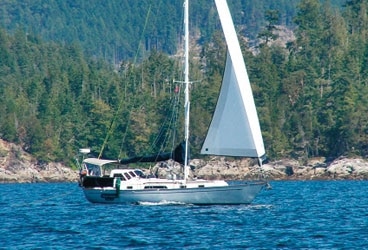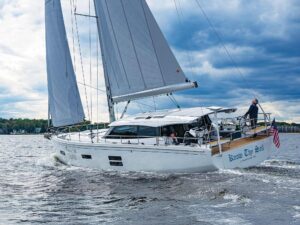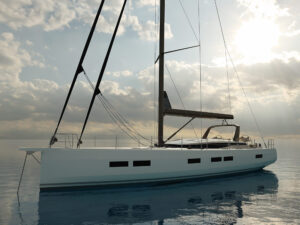
Robert H. Perry says that when he was asked to design a smaller version of the successful Passport 40, he took the opportunity to also improve on the larger boat’s already impressive performance. Along with a beautifully appointed interior and classic lines similar to those of the 40, he gave the Passport 37 a finer bow, which helps to make the boat faster on the wind.
The Passport 37’s lines show a firm turn of the bilge amidships, powerful quarters, a broad stern, and a slight flare to the topsides forward. The solid-fiberglass hull is heavily laid up, and the boat displaces 17,360 pounds, carries 6,250 pounds of ballast in a large fin keel that draws less than 6 feet, and has a skeg-hung rudder. One of the few complaints heard regarding this design concerns its handling under power when reversing. This is in part because the propeller shaft is angled to port so it can be extracted past the skeg.
Under sail, the Passport 37 moves easily through the water, frequently achieving speeds of 5 to 6 knots when close-reaching in 10 knots of wind. On our Passport 37, Potato Caboose, the sloop rig, with a roller-furling headsail and three available reefs in the main, allows us to balance the sails nicely in wind strengths up to 30 or 35 knots. Above 35 knots, we employ a storm jib on an inner forestay and a storm trysail. Potato Caboose is quick in light air, and she goes to weather well. A short-rig version was also offered and seems to have been popular in the San Francisco area.
The Passport 37 was available in five different layouts. In ours, where the V-berth is forward, the fine bow makes for a somewhat narrow master suite. A head with a separate shower stall is just aft and to starboard. Aft of the head is a roomy saloon. A C-shaped settee to starboard and a straight bench to port offer comfortable, deep seating and make good sea berths.
Our favorite interior feature is the galley, which is big for a 37-foot boat and designed to make you feel secure in a seaway. It has a deep double sink, separate refrigerator and freezer compartments, and excellent storage. Opposite the galley is a navigation station with a comfy seat, adequate work area for paper charts, and spaces outboard and forward for mounting electronic instruments.
Typical of the better Taiwan-built boats of the era, the Passport 37 has excellent joinery with rounded surfaces and no bruising corners. The elegant and bright interior, with wood finished in a light varnish and a white vinyl overhead liner accented with teak battens, has been kind to us while living aboard during Pacific Northwest winters.
When we purchased our boat in October 2004, she had more than 6,600 hours on the original 30-horsepower Nanni-marinized Kubota engine. While the block was still strong and more than adequate to drive the boat up to hull speed, the marinized accessories were showing their age. We repowered with a 40-horsepower Universal-marinized Kubota diesel.
Introduced in 1984, the Passport 37 was in production for only three years. Bob Perry attributed the small number built, about 25, to “3-foot-itis”: Not much more money would buy the larger boat. It’s nevertheless a well-built, attractive, and very capable bluewater cruiser.
Due to the low production numbers and its high retention among satisfied owners, Passport 37s come onto the market rarely. Asking prices from $110,000 to $135,000 reflect the excellent build quality of the Passport line as well as the condition and level of outfit of the individual boat.
Brian Rader and his wife, Meaghan, moved aboard Potato Caboose in late 2004 and have been cruising in the Pacific Northwest.








